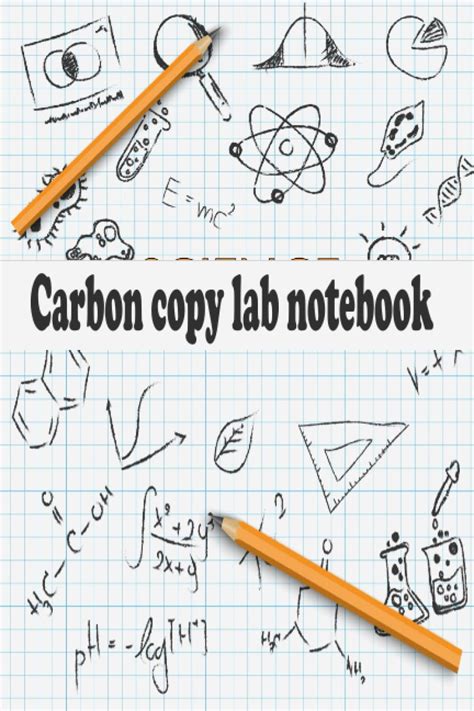Introduction

A carbon copy lab notebook is an indispensable tool for scientists and researchers to document their experimental methods, observations, and results. It serves as a legal record of scientific work and is essential for ensuring data integrity, traceability, and reproducibility.
Why Carbon Copy Lab Notebooks Matter
- Legal Requirements: Many industries and regulatory agencies, such as the pharmaceutical and biotechnology industries, require the use of carbon copy lab notebooks to provide proof of compliance with Good Laboratory Practices (GLP) and other quality standards.
- Data Integrity: Carbon copy notebooks create an exact duplicate of the original, providing a reliable and tamper-proof record of experiments. This reduces the risk of data loss or manipulation, ensuring the accuracy and validity of research findings.
- Traceability: Carbon copies allow for easy tracking of the experimental process, including the researchers involved, the dates and times of experiments, and the materials used. This traceability is crucial for accountability and reproducibility.
- Collaboration and Transparency: Carbon copy notebooks facilitate collaboration among researchers by providing a shared record of ongoing work. They also promote transparency and open science, as they can be shared with colleagues, reviewers, and the scientific community for peer review.
Benefits of Carbon Copy Lab Notebooks
- Accurate and Legible Data: Carbon copy notebooks eliminate the smudges, erasures, and illegible entries that can occur in handwritten notes.
- Tamper-Proof Record: The carbon copy serves as a second layer of protection against data loss or manipulation, safeguarding the integrity of research.
- Reduced Transcription Errors: Carbon copy notebooks minimize transcription errors, as the data is recorded twice during the writing process.
- Time-Saving: Carbon copy notebooks can save time by eliminating the need to manually copy data from lab notes into electronic formats.
How Carbon Copy Lab Notebooks Work
Carbon copy lab notebooks typically consist of two layers:
- Top Sheet: The top sheet is made of special carbonless paper that transfers ink to the sheet below.
- Bottom Sheet: The bottom sheet is made of plain paper that receives the carbon transfer.
When you write on the top sheet, the pressure of your pen or pencil creates enough force to transfer the ink to the bottom sheet, resulting in an exact duplicate.
Common Mistakes to Avoid
- Using Ballpoint Pens: Ballpoint pens can create gaps in the carbon transfer, resulting in incomplete duplicates. Use felt-tip pens or pencils instead.
- Writing Too Lightly: If you don’t press hard enough when writing, the carbon transfer may be faint or smudged. Apply moderate pressure to ensure legible duplicates.
- Crossing Out or Erasing: Avoid crossing out or erasing entries. Instead, draw a line through incorrect data and add a brief explanation in the margin.
- Leaving Blank Spaces: Do not leave large blank spaces in the notebook. If there is no data to record, enter “No Data” or “N/A.”
- Use High-Quality Materials: Invest in durable lab notebooks with high-quality carbonless paper.
- Write Legibly: Take the time to write clearly and legibly on both the top and bottom sheets.
- Document Thoroughly: Include all relevant experimental details, including the purpose of the experiment, methods, observations, and results.
- Sign and Date All Entries: Each entry should be signed and dated by the researcher who performed the experiment.
- Store Securely: Keep lab notebooks in a safe and secure location to protect them from loss or damage.
Beyond traditional laboratory settings, carbon copy lab notebooks have found innovative applications in various fields:
- Forensic Science: Preserving the integrity of crime scene evidence and witness statements.
- Legal Investigations: Documenting interviews, depositions, and witness accounts.
- Business Record-Keeping: Creating secure and tamper-proof records of financial transactions, contracts, and meeting minutes.
- Education and Training: Providing students and trainees with a reliable method to document experiments, lectures, and assignments.
Table 1: Comparison of Lab Notebook Formats
| Format | Advantages | Disadvantages |
|---|---|---|
| Bound Lab Notebook | Durable, professional, legal compliance | Expensive, difficult to make corrections |
| Loose-Leaf Lab Notebook | Flexible, easy to add or remove pages | May be less durable, risk of lost pages |
| Electronic Lab Notebook | Searchable, collaborative, data integrity features | Expensive, requires technical training |
| Carbon Copy Lab Notebook | Accurate, tamper-proof, time-saving | Requires special paper, may be bulkier |
Table 2: Regulatory Requirements for Lab Notebooks
| Industry | Requirement |
|---|---|
| Pharmaceutical | GLP Compliance |
| Biotechnology | GLP Compliance, FDA 21 CFR Part 211 |
| Food and Drug | FDA 21 CFR Part 58 |
| Research Universities | Varies by institution, often GLP-like standards |
Table 3: Features of High-Quality Carbon Copy Lab Notebooks
| Feature | Importance |
|---|---|
| Heavy-Duty Paper | Prevents tearing and water damage |
| Permanent Carbon Transfer | Ensures durability and tamper-proof records |
| Spiral Binding | Allows for easy page flipping and flat writing |
| Clear Page Layout | Facilitates organization and data retrieval |
| Sequential Page Numbering | Prevents page substitution or loss |
Table 4: Innovative Applications of Carbon Copy Lab Notebooks
| Field | Application |
|---|---|
| Crime Scene Investigation | Preserving evidence integrity |
| Legal Investigations | Documenting witness statements |
| Business Record-Keeping | Creating secure financial records |
| Education | Documenting student experiments and assignments |
